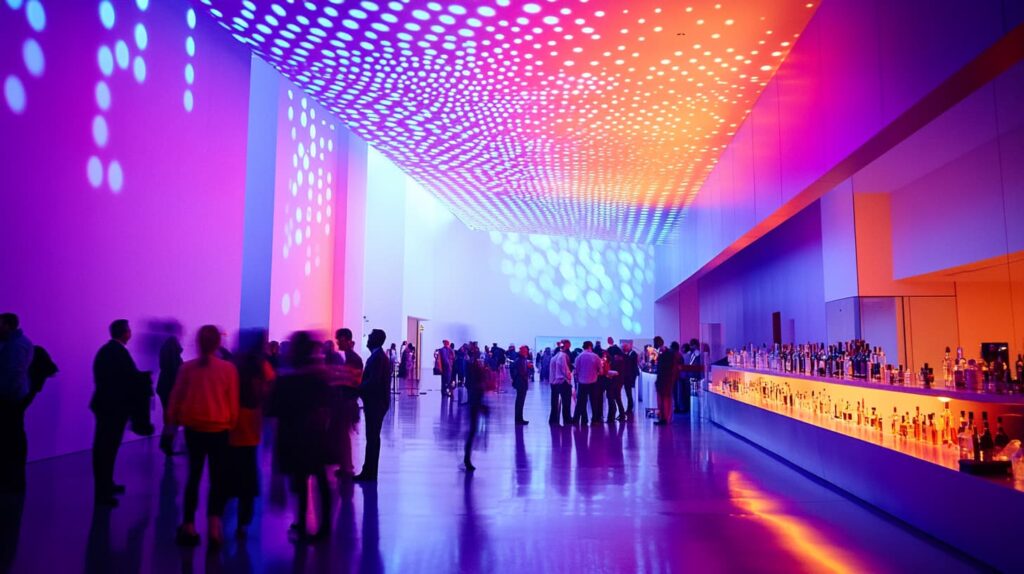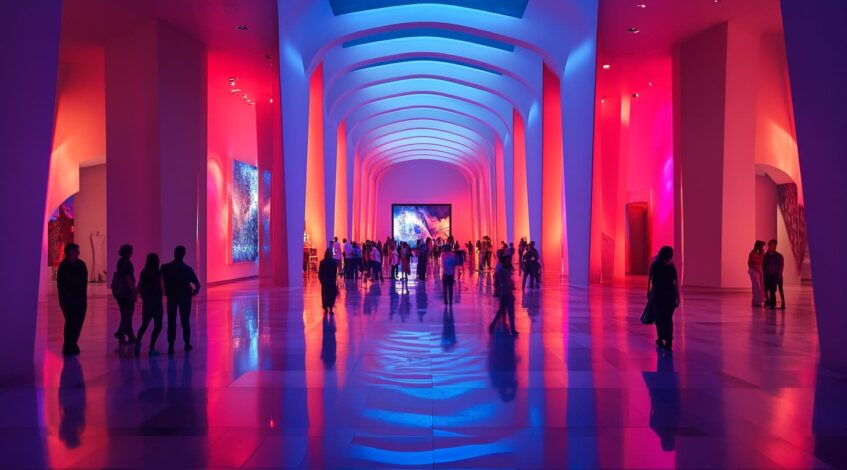Museum soundproofing represents more than just noise reduction—it embodies the delicate balance between preservation and innovation. Historical buildings, with their high ceilings and marble halls, naturally create complex acoustic environments that can either enhance or detract from the visitor experience. Understanding these dynamics requires a deep dive into the physics of sound behavior in large, often architecturally significant spaces.
Sound waves in museums behave differently than in conventional venues, interacting with historical materials and architectural features in unique ways. While traditional approaches to soundproof a museum present significant challenges, modern solutions can address the fact that hard surfaces like marble and glass, common in museum construction, reflect up to 98% of sound energy. Through careful analysis and implementation of sound control measures, museums can maintain their architectural integrity while achieving optimal acoustic performance.
Mastering Museum Acoustics
The implementation of effective soundproofing begins with understanding the distinct characteristics of museum spaces. Modern acoustic treatments must address three critical factors: reverberation time, sound transmission, and vibration control. Recent innovations in materials science have produced solutions that can be seamlessly integrated into historical structures without compromising their aesthetic or structural integrity.
Successful museum soundproofing typically achieves:
- Reverberation time reduction from 3.5 seconds to 1.2 seconds in main halls
- Background noise reduction of 15-20 decibels in gallery spaces
- Vibration isolation that protects artifacts from frequencies as low as 8 Hz
Critical Acoustic Zones
Museums must prioritize different spaces based on their acoustic requirements. Exhibition halls, lecture rooms, and event spaces each demand specialized treatment. The hierarchy of acoustic sensitivity in museums typically follows this pattern:
Primary Protection Zones
- Artifact display areas (35-40 dB maximum)
- Conservation laboratories (30-35 dB maximum)
- Special collections (25-30 dB maximum)
- Multimedia installation spaces (40-45 dB maximum)
Secondary Control Areas
- Event halls
- Public gathering spaces
- Educational workshop rooms
- Administrative offices
The Economics of Acoustic Excellence
A crucial consideration often overlooked in museum acoustic planning is the financial impact of proper soundproofing. Initial investment in acoustic treatments typically represents 3-5% of a museum’s renovation budget but can result in a 30-40% increase in event hosting revenue. Furthermore, proper acoustic treatment reduces long-term maintenance costs by protecting building materials from sound-induced vibration damage.
Risk Mitigation Through Acoustic Design
Sound-induced damage to artifacts represents a significant liability for museums. Professional acoustic treatment acts as an insurance policy against potential damage claims. Recent studies in theindicate that uncontrolled sound vibrations can accelerate the degradation of certain materials by up to 15% annually, particularly affecting textiles, paintings, and delicate ceramics.
Regulatory Compliance and Standards
Museums must navigate complex regulatory frameworks regarding both noise control and historical preservation. Key considerations include:
Building Code Requirements
Modern museum soundproofing must comply with local building codes while adhering to preservation guidelines. This often requires creative solutions that satisfy multiple regulatory bodies without compromising the building’s historical integrity or acoustic performance.
Conservation Standards
International conservation standards now recognize acoustic control as a crucial factor in artifact preservation. The International Council of Museums (ICOM) guidelines specifically address sound levels and vibration control in their preservation protocols.
Operational Excellence Through Acoustic Design
The successful implementation of acoustic control systems requires comprehensive staff training. Museum personnel must understand both the technical aspects of sound management and its importance in preservation efforts. Regular monitoring and maintenance protocols ensure optimal system performance and longevity.

Event Planning Integration
Acoustic considerations must be integrated into event planning procedures. This includes:
Critical Event Planning Factors:
- Maximum occupancy calculations based on acoustic load
- Equipment placement and setup guidelines
- Time-based sound level restrictions
- Buffer zone requirements between simultaneous events
Emergency Preparedness and Acoustic Systems
Safety Integration
Modern acoustic treatments must integrate seamlessly with emergency systems. Fire suppression, emergency announcements, and evacuation procedures should never be compromised by sound control measures. Advanced acoustic design actually enhances safety by ensuring clear communication during emergencies while maintaining sound isolation where needed.
Sustainability and Environmental Impact
Green Acoustic Solutions
The latest developments in museum acoustics emphasize sustainability. New eco-friendly materials and energy-efficient systems help museums reduce their environmental impact while maintaining optimal acoustic conditions. These solutions often incorporate recycled materials and low-VOC components, contributing to better indoor air quality.
Digital Integration and Smart Systems
Technology Enhancement
Modern museum acoustic systems increasingly incorporate digital elements:
- Real-time monitoring through IoT sensors
- Automated adjustment systems responding to occupancy levels
- Integration with building management systems
- Mobile apps for staff control and monitoring
The Modern Museum Experience
The evolution of museums from silent galleries to dynamic cultural centers necessitates a sophisticated approach to acoustic management. Today’s museum visitors expect immersive experiences that can range from quiet contemplation to vibrant social events. This transformation requires innovative solutions that can adapt to varying acoustic needs while maintaining the museum’s core mission of preservation and education.
Engineering Excellence in Historical Spaces
Acoustic treatment in museums presents unique challenges due to preservation requirements and architectural constraints. Modern solutions must often be reversible and non-invasive, leading to innovations in temporary and adjustable sound control systems. The development of micro-perforated panels and tension-mounted acoustic materials has revolutionized how museums approach sound management without compromising historical integrity.
The Technical Symphony: Implementation and Integration
The successful integration of soundproofing systems requires careful consideration of multiple factors:
Sound Control Performance in Museum Environments:
| Surface Type | Treatment Method | Noise Reduction (dB) | Visual Impact |
| Walls | Micro-perforated Panels | 25-30 | Minimal |
| Ceilings | Tension Systems | 20-25 | Low |
| Windows | Acoustic Glazing | 35-40 | None |
| Floors | Floating Systems | 30-35 | Minimal |
Preservation Through Innovation
The protection of priceless artifacts remains paramount in any acoustic modification project. Modern vibration monitoring systems now provide real-time feedback on environmental conditions, allowing for immediate adjustments to protect sensitive collections. These systems integrate with building management technology to create a comprehensive approach to both acoustic control and preservation.
The Next Generation of Museum Spaces
The future of museum acoustics lies in adaptive technologies that can respond to changing needs throughout the day. Smart materials that can alter their acoustic properties based on usage, coupled with AI-driven sound management systems, are beginning to appear in leading institutions worldwide. These innovations promise to further enhance the versatility of museum spaces while ensuring optimal conditions for both artifacts and visitors.
Harmonizing Heritage with Innovation
The transformation of museums through advanced acoustic engineering represents a critical evolution in cultural institution management. By embracing innovative soundproofing technologies while respecting historical preservation requirements, museums can successfully expand their role as community cultural centers. This balance between protection and progression ensures that these beloved institutions remain relevant and sustainable for future generations.
The successful integration of acoustic technology in museum spaces demonstrates that technical innovation and historical preservation can coexist harmoniously. As these institutions continue to evolve, their ability to adapt while maintaining their core mission will depend largely on how well they implement these sophisticated acoustic solutions.

